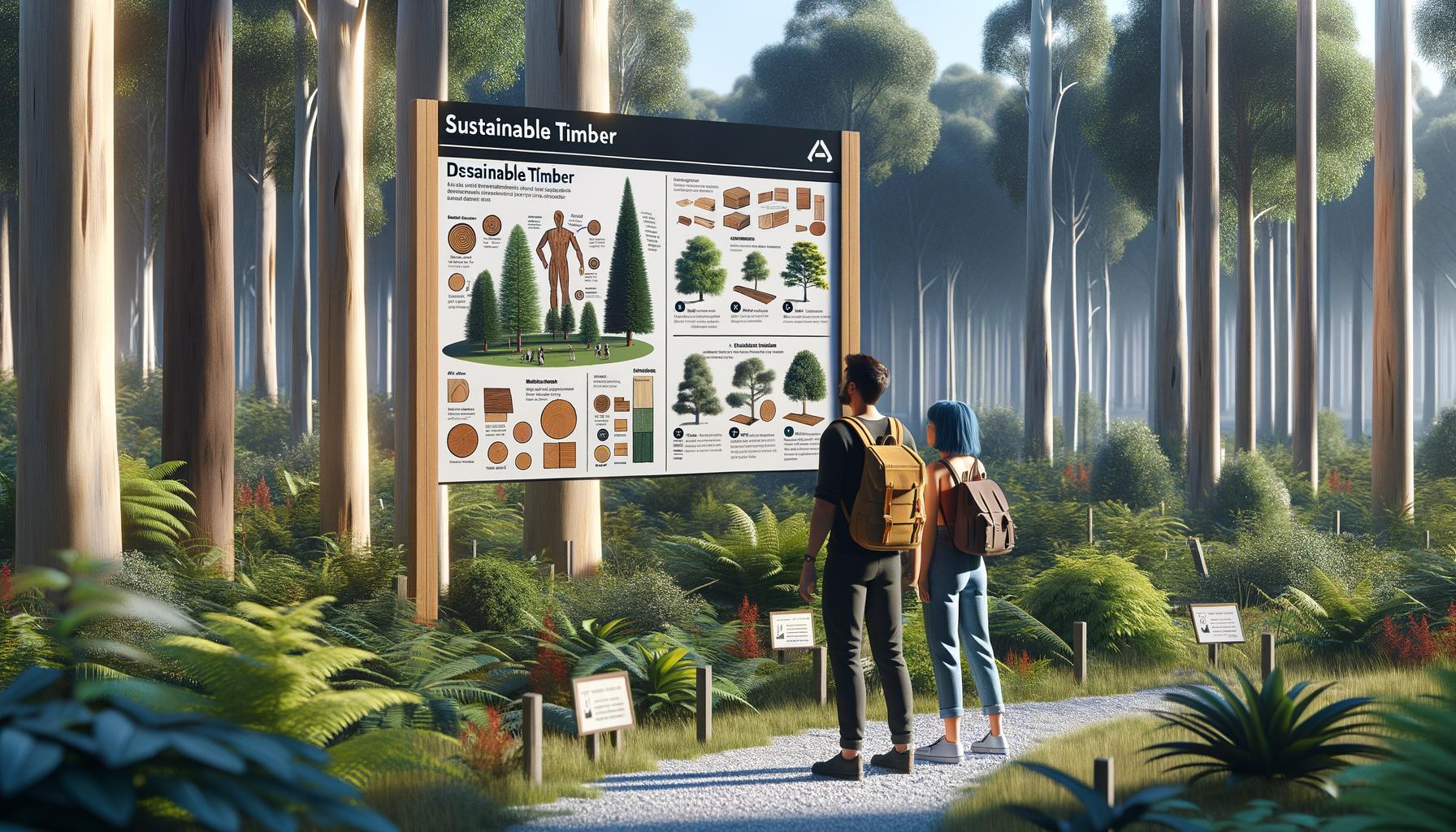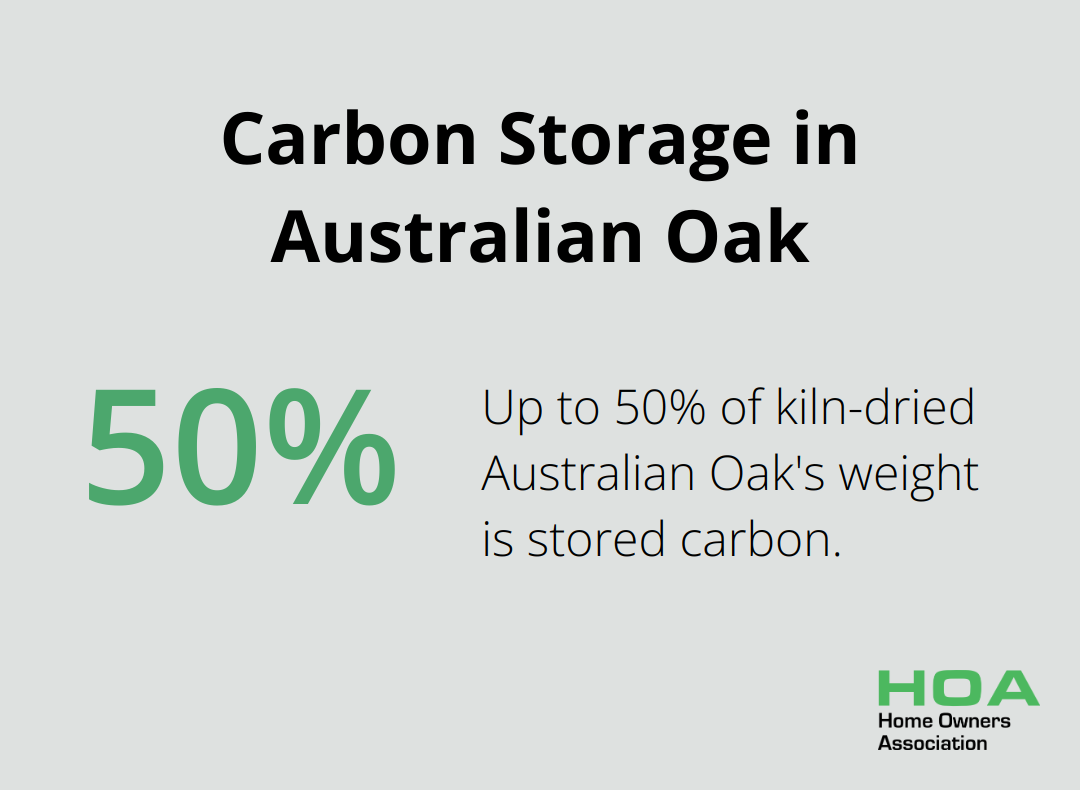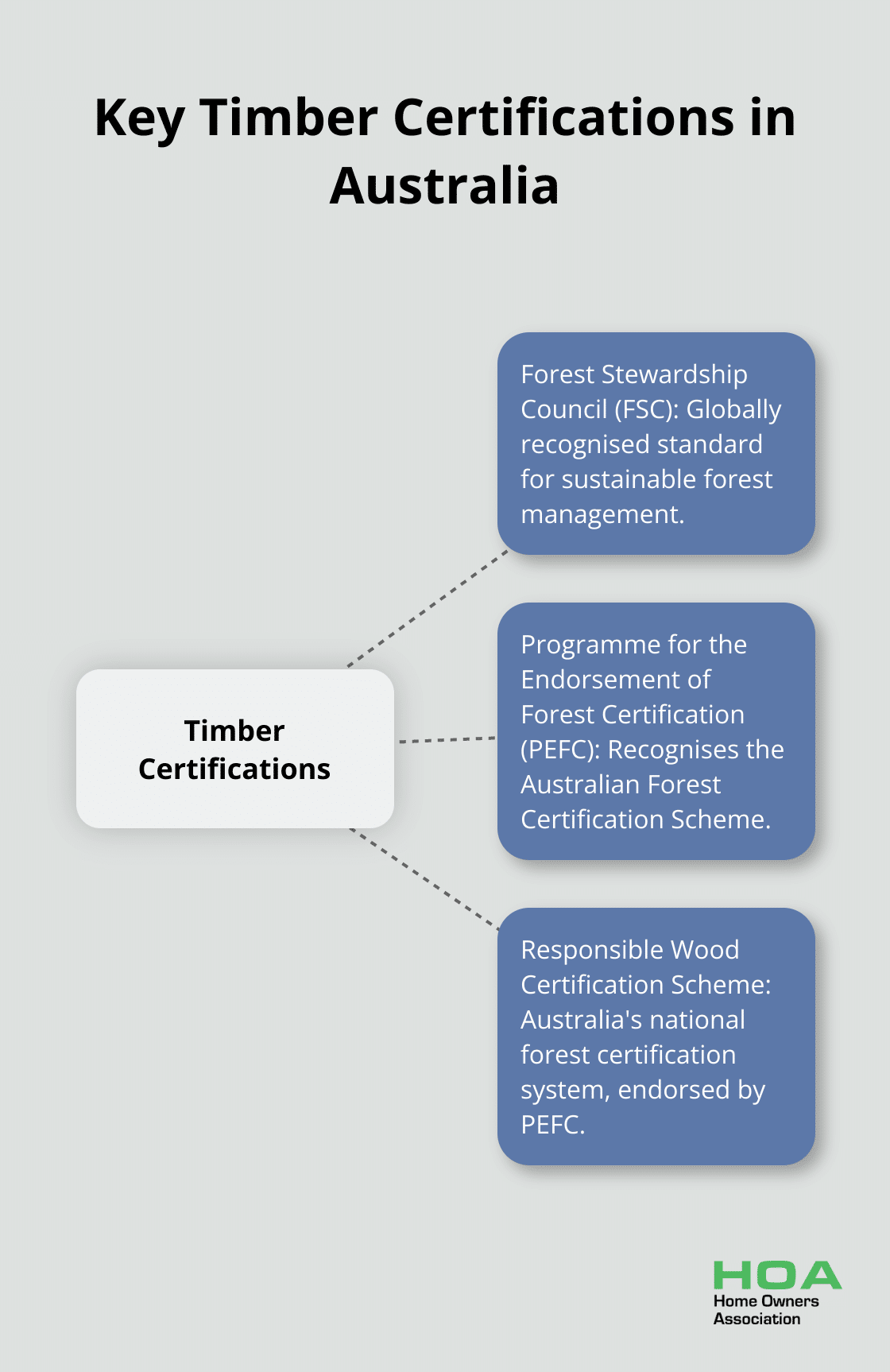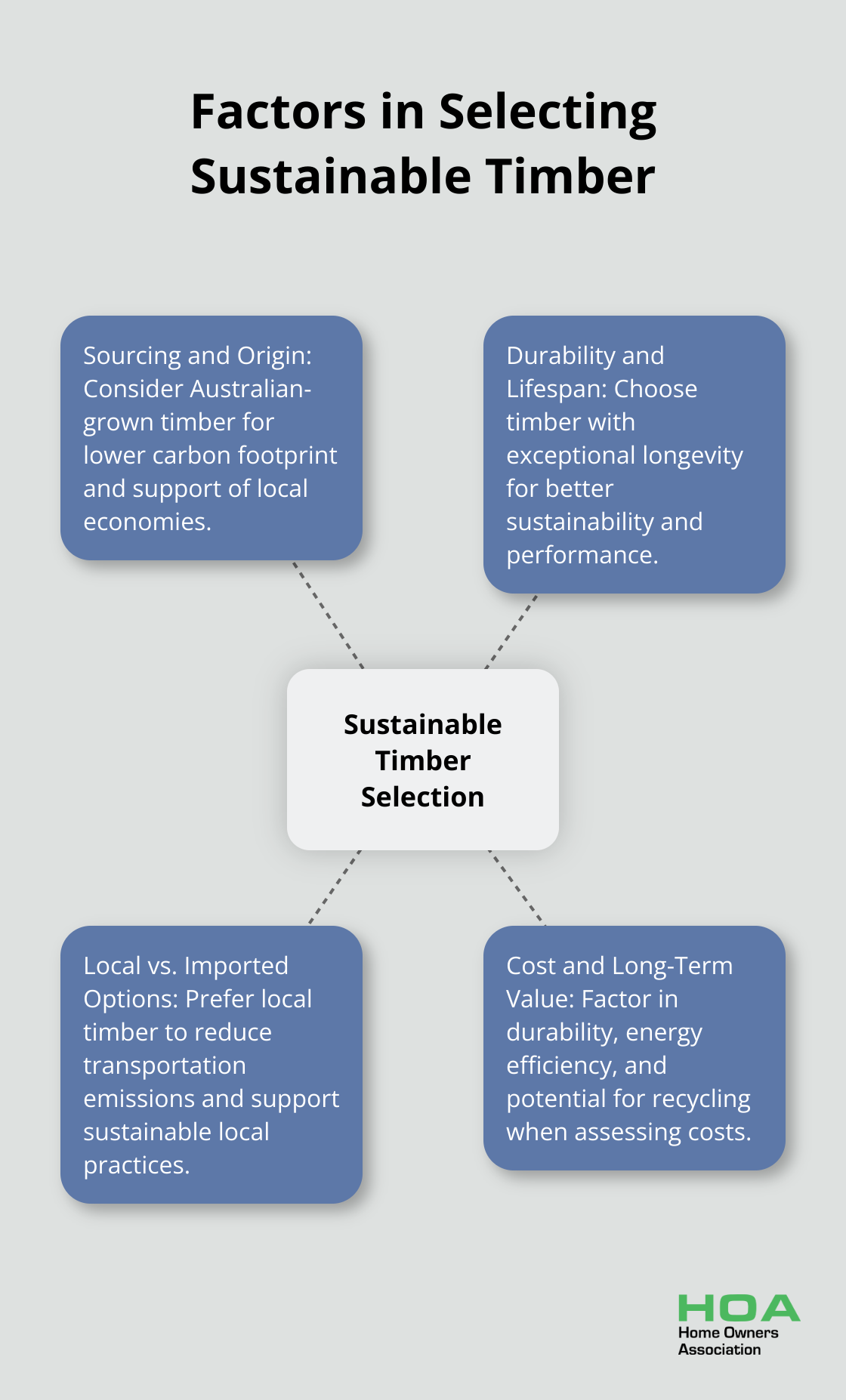
At Home Owners Association, we understand the importance of making sustainable choices in construction.
Selecting the right timber is a critical decision that impacts both your project and the environment.
This sustainable timber guide for Australia will help you navigate the complexities of choosing eco-friendly wood options.
We’ll explore certifications, key factors to consider, and how to make informed decisions that contribute to responsible forestry practices.
What Is Sustainable Timber?
Definition and Importance
Sustainable Forest Management (SFM) entails the management of forests to maintain their full range of environmental, social and economic values. The timber industry contributed approximately AUD 2.1 billion to the Australian economy in 2021 (Australian Bureau of Agricultural and Resource Economics). This economic benefit underscores the need for wise forest management.
In 2017–18, 32.9 million m3 of logs were harvested in Australia, generating $4.9 billion in sales and service income across the forestry and logging industry. This careful approach ensures forests remain healthy and productive for future generations. Sustainable forestry also supports local communities by providing jobs and economic stability in rural areas.
Environmental Advantages
Choosing sustainable timber offers numerous environmental benefits. Timber naturally stores carbon, which helps mitigate climate change. Up to 50% of the weight of kiln-dried Australian Oak is stored carbon, which significantly aids in life cycle assessment considerations.

Sustainable timber requires less energy to produce compared to materials like steel or concrete. This lower energy requirement translates to reduced greenhouse gas emissions. The Australian government plans to increase wood use in construction by 2030 as part of its commitment to low carbon construction.
Sustainable Australian Timber Species
Australia boasts several sustainable timber species ideal for construction and home improvement projects:
- Blackbutt: Known for its durability and fire resistance, making it suitable for bushfire-prone areas.
- Spotted Gum: Prized for its aesthetic appeal and strength.
- Radiata Pine: A fast-growing, plantation-grown softwood widely used in construction framing and furniture.
Selecting the Right Timber
When choosing sustainable timber, consider these factors:
- Project requirements (durability, appearance, intended use)
- Environmental impact
- Local availability
- Cost and long-term value
Your choice of sustainable timber not only enhances your home but also contributes to the preservation of Australia’s unique forest ecosystems.
As we move forward, it’s important to understand the certifications and standards that guarantee the sustainability of timber in Australia. These certifications provide assurance that the timber you choose aligns with responsible forestry practices.
Navigating Timber Certifications in Australia
Forest Stewardship Council (FSC) Certification
The Forest Stewardship Council (FSC) certification stands as a globally recognised standard. Over 20 million hectares of Australian native and plantation forest is certified. The FSC logo on timber products indicates that the wood originates from forests managed according to strict environmental and social standards.
Programme for the Endorsement of Forest Certification (PEFC)
The Programme for the Endorsement of Forest Certification (PEFC) represents another important certification to consider. PEFC recognises the Australian Forest Certification Scheme (Responsible Wood), which endorses sustainable forest practices in Australia. This certification ensures that timber products come from forests managed in line with internationally accepted sustainability benchmarks.
Responsible Wood Certification Scheme
Australia’s own national forest certification system, the Responsible Wood Certification Scheme, has received endorsement from PEFC. This endorsement signifies that it meets rigorous international standards. The Responsible Wood logo on timber products guarantees that they originate from sustainably managed Australian forests, supporting local sustainable forestry practices.

Verifying Certifications
To authenticate these certifications, look for the respective logos on timber products or request chain-of-custody certificates from suppliers. These certificates allow you to trace the timber back to its certified source. Both FSC and PEFC provide online certificate databases for certification verification.
Benefits of Certified Timber
Choosing certified timber offers more than environmental responsibility. Timber sourced from sustainably managed forests often exhibits superior qualities in terms of strength and longevity. This demonstrates that sustainable choices can also yield benefits in the long term.
The Home Owners Association recommends prioritising certified timber for construction projects. These certifications not only ensure environmental responsibility but often indicate higher quality materials (a crucial factor for durability and longevity in construction).
Understanding these certifications equips you to make informed decisions when selecting timber for your projects. The next section will explore specific factors to consider when choosing sustainable timber, helping you select the best option for your needs and the environment.
How to Select the Best Sustainable Timber
Sourcing and Origin
The source of your timber plays a key role in sustainability. Australian-grown timber often has a lower carbon footprint due to reduced transportation needs. Spotted Gum, a popular Australian hardwood, offers an excellent choice for durability, beauty, and versatility in many applications. These species typically come from well-managed forests, which supports local economies and reduces environmental impact.
Durability and Lifespan
The longevity of your chosen timber directly impacts its sustainability. Hardwoods like Jarrah offer exceptional durability for outdoor applications, thanks to its deep red colour and natural resistance to decay and insects. For indoor use, Hoop Pine provides a sustainable option with a straight grain, making it ideal for joinery and furniture.
Local vs. Imported Options
Imported timber sometimes costs less upfront but often comes with hidden environmental costs. Transportation emissions and potential issues with sustainable forestry practices in other countries can offset any initial savings.
Australian timber certification schemes (such as the Australian Forest Standard) provide assurance of sustainable local options. These certifications ensure that timber comes from responsibly managed forests, supporting both the environment and the local economy.
Cost and Long-Term Value
Sustainable timber might seem more expensive at first glance. However, its durability and potential to increase property value often result in better long-term value. For example, timber windows naturally outperform similar aluminium models in energy efficiency (indicated by lower ‘U’ values). This improved energy efficiency can lead to significant savings on heating and cooling costs over time.
The timber industry in Australia promotes regrowth. All natural forests managed for timber production must be regrown by law, ensuring a continuous supply of sustainable timber for future projects.
When considering costs, factor in the potential for recycling and repurposing. The growing trend of using reclaimed timber not only reduces waste but can add unique character to your project, potentially increasing its value.

Final Thoughts
Choosing sustainable timber in Australia impacts both your project and the environment. Certifications like FSC, PEFC, and Responsible Wood verify the eco-friendly credentials of your timber choices. Our sustainable timber guide for Australia emphasises the importance of considering factors such as origin, durability, and long-term value when selecting wood.
Australian-grown species like Spotted Gum and Blackbutt offer excellent sustainability profiles while supporting local economies. Sustainable options might seem more expensive initially, but their longevity and potential to increase property value often result in better financial outcomes over time. The timber industry in Australia promotes regrowth, ensuring a continuous supply of sustainable timber for future projects.
At Home Owners Association, we help Melbourne homeowners make informed decisions about sustainable construction practices. Our members receive trade pricing, discounts, and expert advice to ensure their projects meet high standards of quality and sustainability. The power to shape a more sustainable future lies in the materials we choose for our homes and projects.





